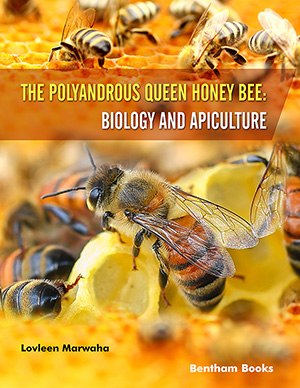Abstract
Queen Mandibular Pheromones (QMP) include (E)-9-oxo-2-decanoic
acid(9-ODA), (R)-and (S)-(E)-9-hydroxy-2-decanoic acid(9-HDA), methyl 4-
hydroxybenzoate(HOB), 10-hydroxy-decanoic acid (10-HDAA), 4-hydroxy-
-methoxyphenyl ethanol (HVA), and10-hydroxy-2 (E)-decanoic acid (10-HDA),
whereas worker honey bees mandibular gland pheromones include mainly 10-hydrox-
-2 (E)-decanoic acid (10-HDA),10-hydroxydecanoic acid (10-HDAA), and 2- mainly
2-heptanone (2-H), traces of 9-hydroxy-2 (E)-decanoic acid (9-HDA) and 9-ODA.
Biochemical modifications of stearic acid occur through hydroxylation of stearic acid
at ω or ω-1 positions in worker honey bee and queen, synthesizing the primary
pheromones listed above. 9-ODA pheromone influences alcohol dehydrogenase gene
expression, and the specific enzyme is essential for converting 9-HDA to 9-ODA in
worker honey bees. Further, the differential synthesis process is influenced by the gene
expression of various cytochromes. QMPs impose differential influence on various
developmental, functional, and behavioural regulations on nest mates, which include
retinue behaviour, suppression of the development of worker honey bee ovaries, wax
secretion, drone attraction, swarming, queen dominance regulation, general regulation,
mating, and reproduction, juvenile hormone secretion in workers, foraging behaviour
and the different submissive response of workers in the presence of the queen.
Keywords: Differential secretion, Genetic elements, Mandibular gland, Pheromones.






















